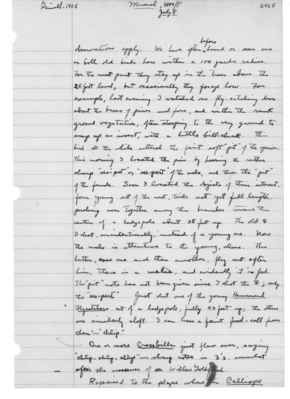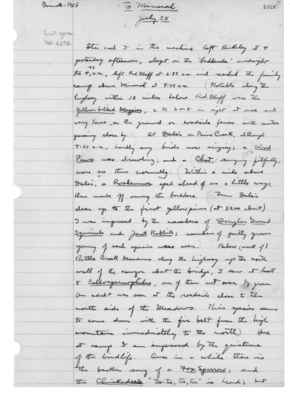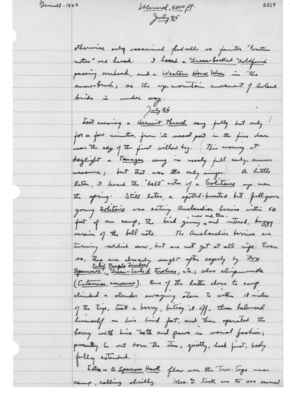Pages That Mention fir
1925: Joseph Grinnell's field notes
S2 Page 72
Collector: Grinnell - 1925 Location: Mineral, 4800 ft. Date: July 8 Page Number: 2525
observation apply. We have often ^before head or seen one or both old birds here within a 100 yards radius. For the most part they stay up in the trees above the 25-foot level, but occasionally they forage. For example, last evening I watched one fly-catching down about the bases of pines and firs, and within the rank ground vegetation, often stooping to the very ground to snap up an insect, with a little bill-click. This bird all the while uttered the faint soft "pit" of the species. this morning I located the pair by hearing the rather sharp "see-put" or "see-pert" of the male, and then the "pit" of the female. Soon I located the objects of their interest, four young out of the nest, tails not yet full length, perching near together among the branches toward the center of a lodgepole about 25 feet up. The old [female symbol] I shot, unintentionally, instead of a young one. The latter, now one and then the other, fly out after him, there is a melee, and evidently it is fed. The "pit" note has not been given since I shot the [female symbol], only the "see-pert." Just shot one of the young Hammond Flycatchers out of a lodgepole, fully 40 feet up; the others are similarly aloft. I can heard a faint food-call from them - "chlip."
One or more Crossbills just flew over, saying "chup - chup - chup" - sharp notes in 3's, somewhat after the manner of a Willow Goldfinch.
Repaired to the place where the Calliope
S2 Page 75
Collector: Grinnell - 1925 Location: To Mineral Date: July 25 Page Number: 2528
Last spec. no. 6292
Stu and I in the machine left Berkeley at 4 yesterday afternoon, slept on the "badlands" midnight to 4:45 a.m., left Red Bluff at 6:15 a.m. and reached the family camp above Mineral at 9:45 a.m. Notable along the highway within 12 miles below Red Bluff were the Yellow-billed Magpies, 2 to 6 or 8 in sight at once and very tame, on the ground or roadside fences with autos passing close by. At Dale's on Paine Creek, although 7:30 a.m., hardly any birds now singing; a Wood Pewee was drawling, and a Chat singing fitfully, more so than normally. Within a mile above Dale's, a Roadrunner sped ahead of us a little ways, then made off among the boulders. From Dale's clean up to the first yellow pines (at 3200 about) I was impressed by the numbers of Douglas Ground Squirrels and Jack Rabbits; numbers of partly grown young of each species were seen. Below (west of) Battle Creek Meadows along the highway up the north wall of the canyon about the bridge, I saw at least 8 Callospermophilus, one of them not over 1/3 grown. An adult was seen at the roadside close to the north side of the Meadows. This species seems to come down with the fir belt from the high mountain immediately to the north. Here at camp I am impressed by the quietness of the birdlife. Once in a while there is the broken song of a Fox Sparrow; and the Chickadee's "tee-tee, too, too" is heard; but
S2 Page 76
Collector: Grinnell - 1925 Location: Mineral, 4800 ft. Date: July 25 Page Number: 2529
otherwise only occasional food calls or fainter "location notes" are heard. I heard a Green-backed Goldfinch passing overheard, and a Western House Wren in the snow-brush; so the up-mountain movement of lowland birds is under way.
July 26 Last evening a Hermit thrush sang fully but only for a few minutes, from its usual post in the firs down near the edge of the first willow bog. This morning at daylight a Tanager sang in nearly full early summer measure; but that was the only singer. A little later, I heard the "bell" notes of a Solitaire up near the spring. Still later, a spotted-breasted but full-grown young Solitaire was eating Amelanchier berries within 50 feet of our camp, the bird giving ^now and then an intoned, buzzy version of the bell note. The Amelanchier berries are turning reddish now, but not yet at all ripe. Even so, they are already sought after eagerly by Fox Sparrows, ^Calif. Purple Finches, Green-tailed Towhees, etc; also chipmunks (Eutamias amoenus). One of the latter close to camp climbed a slender swaying stem to within 18 inches of the tip, took a berry, biting it off, then balanced himself on his hind feet, and then operated the berry with his teeth and paws in usual fashion; presently he went the stem, quietly, head first, body fully extended.
Later - A Sparrow Hawk flew over the tree-tops near camp, calling shrilly. Mrs. G. took me to see several
S2 Page 77
Collector: Grinnell - 1925 Location: Mineral, 4800 ft. Date: July 26 Page Number: 2530
of the nest she has under observation - Robin ^(2 eggs), Wright Flycatcher ^(3 eggs), Green-tailed Towhee (3 small young). She is keeping full, formal notes on all these, so I won't repeat. The most astonishing thing is the second set of eggs of Wright Flycatcher in the same nest a brood of 4 was raised in, this season. As far as I can see, the nest is in excellent condition, clean and compact; of course is might have - probably was - re lined and otherwise renovated at the beginning of the second mating.
Jumped a fawn here by camp, from a lying-down place under a very small fir surrounded by dense ceanothus cordulatus save for a poorly marked entrance gangway. The deer somehow got thru [sic] the mass of entanglements opposite me as I came in along the "gangway"; I noted mentally that it was a "jack rabbit" until it bounded into the open beyond, behaving, in movements, just like an old deer, tho it certainly wasn't more than 1/4 grown.
6293 Calaveras Warbler [male symbol] im. 8.1g. Shot out of hemlock, 25 feet up, where looked much larger than it proved to be.
6294 Sierra Crossbill [male symbol] ad. 29.6g. Shot out of top of hemlock about 25 feet above steeply sloping mountain-side. Testes [testes illustration]. With at least 5 others scattered about in tops of closely adjacent hemlocks, these latter abundantly producing the green pendant cones. I was mentally sure the crossbills were feeding on these cones; if even when skinning the bird shot, and I
S2 Page 81
Collector: Grinnell - 1925 Location: Broke-off Mt. Date: July 27 Page Number: 2533
foliage which the breeze kept in disconcerting agitation); Cassin Purple Finch (2 or more, distantly heard and seen in tops of hemlocks); Sierra Grouse (2, as above); Hammond Flycatcher (2 immatures, separately, seen closely in hemlocks at 8000 to 9000 ft.); Junco (2, in hemlocks).*
In the red-fir belt (Canadian), 8000 ft., about, down to 7000 ft., where we left the machine, noted: Deer (doe and fawn at edge of alder thicket); Callospermophilus (2 or more); Thomomys monticola (sign common); Fox Sparrow (one immature near patch of heather along little stream at 8000 ft., and others heard in alder patches); Juncos (commonest bird, one [male symbol] singing at tip of lofty red fir - many full-grown young in scattering troupes); Evening Grosbeak (one family of 5 or so alighted on dead lower branches of a fir and notes of others were heard now and then); Solitaire (one flushed from ground); Siskin (notes of 2 or 3 heard overhead); Blue-fronted Jay (heard several times); Cassin Vireo (2 immatures closely seen in a jungle of white alders); Hammond Flycatcher (weak call notes heard often, and one bird seen, 30 feet or so up in densely shaded branchwork of fir); Wood Pewee (pair at 7000 ft.); Pileated Warbler (song of one heard from alders); Robin (a pair at a little ^moraine lake in the fir woods was noisily concerned at our presence); Audubon Warbler (a family, male singing, in trees at this same lake); Canada Nuthatch (notes heard in the distance).




